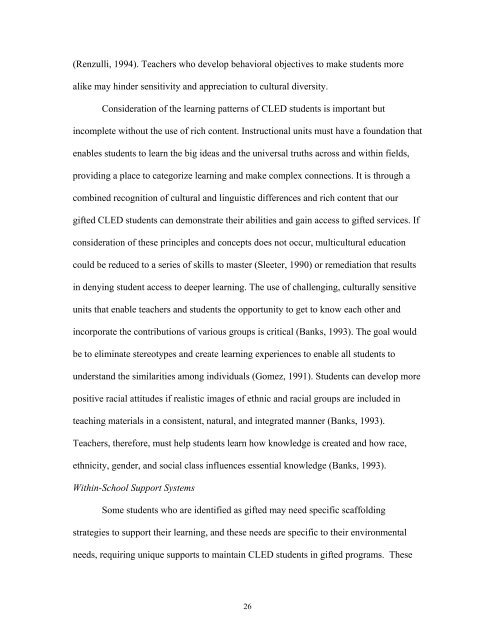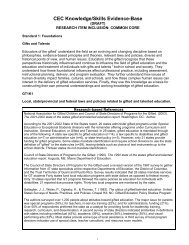Chapter One An Introduction to the Topic of Cultural Diversity - NAGC
Chapter One An Introduction to the Topic of Cultural Diversity - NAGC
Chapter One An Introduction to the Topic of Cultural Diversity - NAGC
Create successful ePaper yourself
Turn your PDF publications into a flip-book with our unique Google optimized e-Paper software.
(Renzulli, 1994). Teachers who develop behavioral objectives <strong>to</strong> make students more<br />
alike may hinder sensitivity and appreciation <strong>to</strong> cultural diversity.<br />
Consideration <strong>of</strong> <strong>the</strong> learning patterns <strong>of</strong> CLED students is important but<br />
incomplete without <strong>the</strong> use <strong>of</strong> rich content. Instructional units must have a foundation that<br />
enables students <strong>to</strong> learn <strong>the</strong> big ideas and <strong>the</strong> universal truths across and within fields,<br />
providing a place <strong>to</strong> categorize learning and make complex connections. It is through a<br />
combined recognition <strong>of</strong> cultural and linguistic differences and rich content that our<br />
gifted CLED students can demonstrate <strong>the</strong>ir abilities and gain access <strong>to</strong> gifted services. If<br />
consideration <strong>of</strong> <strong>the</strong>se principles and concepts does not occur, multicultural education<br />
could be reduced <strong>to</strong> a series <strong>of</strong> skills <strong>to</strong> master (Sleeter, 1990) or remediation that results<br />
in denying student access <strong>to</strong> deeper learning. The use <strong>of</strong> challenging, culturally sensitive<br />
units that enable teachers and students <strong>the</strong> opportunity <strong>to</strong> get <strong>to</strong> know each o<strong>the</strong>r and<br />
incorporate <strong>the</strong> contributions <strong>of</strong> various groups is critical (Banks, 1993). The goal would<br />
be <strong>to</strong> eliminate stereotypes and create learning experiences <strong>to</strong> enable all students <strong>to</strong><br />
understand <strong>the</strong> similarities among individuals (Gomez, 1991). Students can develop more<br />
positive racial attitudes if realistic images <strong>of</strong> ethnic and racial groups are included in<br />
teaching materials in a consistent, natural, and integrated manner (Banks, 1993).<br />
Teachers, <strong>the</strong>refore, must help students learn how knowledge is created and how race,<br />
ethnicity, gender, and social class influences essential knowledge (Banks, 1993).<br />
Within-School Support Systems<br />
Some students who are identified as gifted may need specific scaffolding<br />
strategies <strong>to</strong> support <strong>the</strong>ir learning, and <strong>the</strong>se needs are specific <strong>to</strong> <strong>the</strong>ir environmental<br />
needs, requiring unique supports <strong>to</strong> maintain CLED students in gifted programs. These<br />
26

















